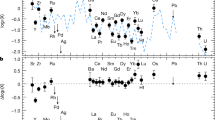Abstract
In extremely metal-poor stars ([Fe/H]≤ − 2.5) the neutron capture elementsare characterized by a 300-fold dispersion in M/Fe ratios which decreases with increasing metallicity, the median M/Fe ratio increases with increasing [Fe/H], but the averageM/Fe number ratio is approximately constant. These observations are consistent witha highly dispersed intrinsic yield of neutron-capture elements in supernova (SN) events,and a progression to increasing metallicity by stochastic chemical evolution.The abundance trends indicate that the synthesis of elements heavier thanbarium was dominated by the r-process. The Sr/Ba ratio shows a dispersionwhich suggests a stochastic source of Sr in excess of the r-process value;possibly due to the alpha-rich freeze out.The iron-peak elements Cr, Mn, and Co show non-solar abundance ratios forextreme metal-poor stars, and no measurableintrinsic dispersion relative to iron. We discuss chemical evolution models which explain these observations.
Similar content being viewed by others
References
Cowan, J.J., Burris, D.L., Sneden, C., McWilliam, A. and Preston, G.W.: 1995, Astrophys. J. 439, L51.
Busso, M., Lambert, D.L., Beglio, L., Gallino, R., Raiteri, C.M. and Smith, V.V.: 1995, Astrophys. J. 446, 775.
Cowan, J.J., McWilliam, A., Sneden, C. and Burris, D.L.: 1997, Astrophys. J. 480, 246.
Cowan, J.J., Pfeiffer, B., Kratz, K.-L., Thielemann, F.-K., Sneden, C., Burles, S., Tytler, D. and Beers, T.C.: 1998, Astrophys. J. (submitted).
Gacquer, W.: 1997, IAUS 187, 102.
Gilroy, K.K., Sneden, C., Pilachowski, C.A. and Cowan, J.J.: 1988, Astrophys. J. 327, 298.
Gratton, R.G. and Sneden, C.: 1988, Astron. Astrophys. 204, 193.
Gratton, R.G. and Sneden, C.: 1994, Astron. Astrophys. 287, 927.
Griffin, R., Griffin, R., Gustafsson, B. and Vieira, T.: 1982, Mon. Not. R. Astron. Soc. 198, 637.
MacConnell, D.J. and Frye, R.L.: 1972, Astron. J. 77, 384.
Magain, P.: 1995, Astron. Astrophys. 297, 686.
McWilliam, A., Preston, G.W., Sneden, C. and Searle, L.: 1995, Astron. J. 109, 2736 (MPSS95).
McWilliam, A.: 1998, Astron. J. 115, 1640.
Raiteri, C.M., Gallino, R., Busso, M., Neuberger, D. and Käppeler, F.: 1993, Astrophys. J. 419, 207.
Ryan, S.G. and Norris, J.E.: 1991, Astron. J. 101, 1865.
Ryan, S.G., Norris, J.E. and Beers, T.C.: 1996, Astrophys. J. 471, 254.
Searle, L. and McWilliam, A.: 1998, in progress.
Shigeyama, T. and Tsujimoto, T.: 1998, Astrophys. J. 507, L135.
Sneden, C. and Parthasarathy, M.: 1983, Astrophys. J. 267, 757.
Sneden, C., McWilliam, A., Preston, G.W., Cowan, J.J., Burris, D.L. and Armosky, B.J.: 1996, Astrophys. J. 467, 819.
Truran, J.W.: 1981, Astron. Astrophys. 97, 391.
Woosley, S.E. and Hoffman, R.D.: 1992, Astrophys. J. 395, 202.
Author information
Authors and Affiliations
Rights and permissions
About this article
Cite this article
McWilliam, A., Searle, L. Abundance Ratios in Extreme Metal-Poor Stars. Astrophysics and Space Science 265, 133–140 (1999). https://doi.org/10.1023/A:1002166217405
Issue Date:
DOI: https://doi.org/10.1023/A:1002166217405




